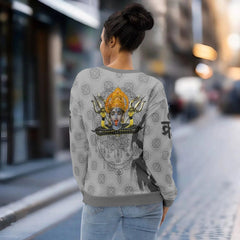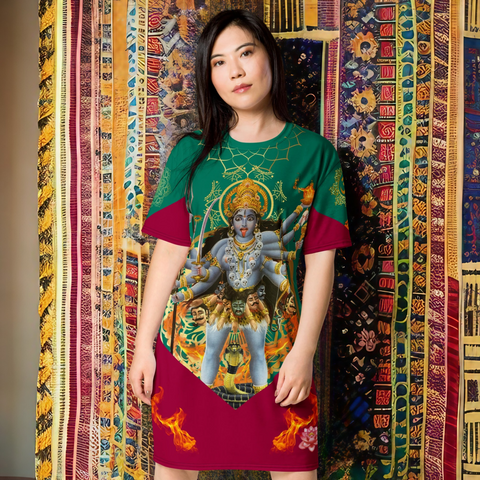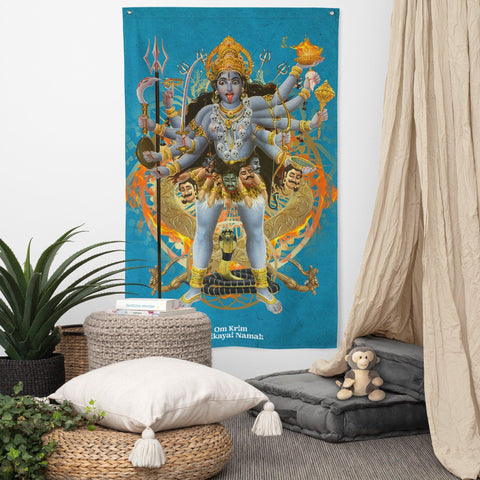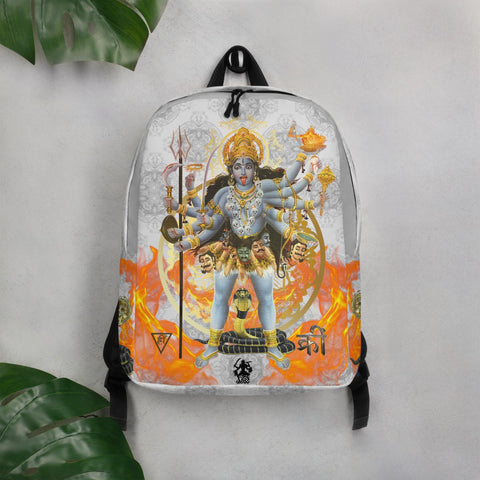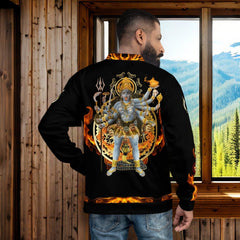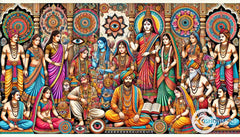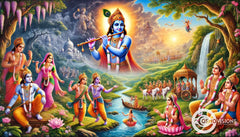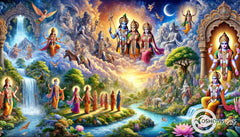Kali and Shiva - Exploring the Power of Hindu Goddess Kali and Lord Shiva
Posted by Massimiliano Geraci
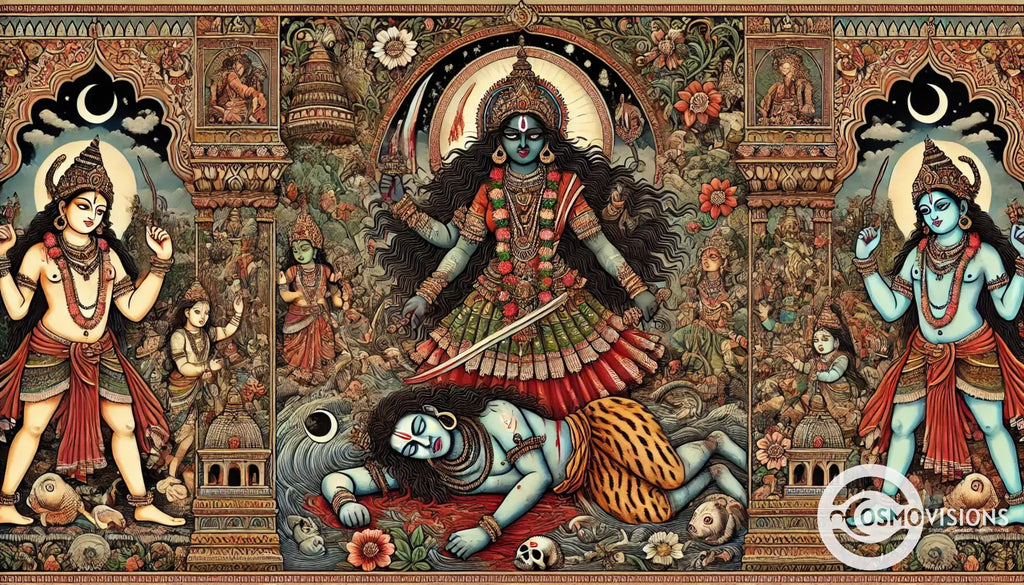
Many people find the vast landscape of Hindu mythology both fascinating and complex. With a pantheon rich in deities, each embodying different aspects of life and the universe, it's easy to feel overwhelmed by the intricate stories and teachings they offer.
One common question that often arises is about the relationship between two powerful figures: Goddess Kali and Lord Shiva. What makes these entities so captivating in Hinduism?
Goddess Kali, known for her fierce form and Lord Shiva, recognized as a force of destruction as well as creation, share a unique bond that is celebrated and revered across various texts like the Puranas and Upanishads.
This article aims to explore their profound connection—focusing on myths like Kali standing on Shiva’s chest—and how their stories convey deeper truths about balance, power, and devotion.
By understanding their narratives, one gains insight into the dual nature of existence itself.
Join us on this spiritual journey. Discover why these deities hold such significance in the hearts of many.
Who is Goddess Kali in Hinduism?
Goddess Kali, revered in Hinduism as the embodiment of Shakti, symbolizes the profound aspects of life and death, creation and destruction. Her depiction is striking: a warrior goddess adorned with a garland of severed heads, each representing the ego cut by divine wisdom.
Kali wields a sword in one hand, showing her ability to sever ties to worldly attachments and ignorance. Her fierce form challenges followers to confront their own limitations and understand the transient nature of existence.
Kali's stories fill sacred texts like Devi Mahatmya within Puranas and Upanishads, illustrating her role not just as destroyer but also as protector. She emerged victorious from battles with demons such as Raktabija by preventing his blood from creating more demons - showcasing her innovative strategies in overcoming evil.
Every drop of his blood she prevented from reaching earth thwarted chaos, earning her titles like Mother Kali and Dakshina Kali for forms displaying both benevolence and ferocity. Worshipers celebrate her power through mantras and rituals that seek her guidance on the path to moksha (liberation) while acknowledging Kali’s dual nature embracing both nurturing love for children and untamed fierceness toward adversaries.

Introduction to Goddess Kali and Her Significance
Goddess Kali embodies the ultimate form of divine energy, known in Hinduism as Shakti. Her origins trace back to ancient texts, capturing the essence of life, death, and the cycle of creation and destruction.
The image of Kali often depicts her standing victorious over the inert body of Lord Shiva, symbolizing her role as the goddess of time (Kāla) and change beyond human comprehension.
She wears a garland made from severed heads and holds weapons and a blood-filled goblet, demonstrating her prowess in battle against forces that threaten cosmic order.
Her significance extends beyond mere iconography; she represents empowerment, fierce motherly love, and liberation from egoic illusions. As worshipped across various practices within Hinduism—from Tantric rituals to mainstream prayers—Kali's multifaceted nature challenges devotees to understand deeper aspects of reality through devotion (Bhakti).
In shedding light on Goddess Kali’s significance within religious texts like Upanishads and Puranas next showcases how narratives sculpted around her have influenced cultural perceptions on divinity, Tantra, and matriarchy in spirituality.
Forms of Kali: Dakshina Kali and Tantric Kali
Dakshina Kali, depicted with her right foot forward, symbolizes the more benevolent aspects of Kali's character. Worshipers see her as a Mother Goddess who offers liberation and destroys evil.
In this form, she holds a sword to slay the demons of ignorance and ego, while her gentle smile reassures devotees of her maternal affection. Her portrayal embodies a balance between destruction and protection, emphasizing Kali’s role in maintaining cosmic order.
Tantric Kali, on the other hand, steps into the world with her left foot forward—a signifier of the path less traveled: Tantrism. This depiction aligns with practices that transcend conventional norms to seek divine enlightenment.
Here, Kali emerges as Vama Kali or Mahakali—the dark goddess associated with time’s inexorable flow and life’s inevitable end. Tantric practitioners delve deep into rituals involving Chhinnamasta and Tara (Mahavidya), elements invoking profound transformations within human consciousness through symbolic death and rebirth processes.
Both forms capture essential facets of Hindu spirituality—unlocking paths to understanding life's cyclical nature through devotion to goddess Kali.
Goddess Kali in Sacred Texts: Upanishads and Puranas
Transitioning from the diverse forms of Goddess Kali, we examine sacred texts such as the Upanishads and Puranas to further understand her significance in Hinduism. The Chandogya Upanishad, one of the oldest, introduces a powerful notion of Kali as Brahman, the ultimate reality or cosmic spirit.
This depiction lays a foundational understanding for her worshipers within Vedanta philosophy. Meanwhile, in Puranic literature, particularly in the Devi Mahatmya section of the Markandeya Purana, she emerges victorious over demons like Raktabīja.
These stories highlight her might and symbolize the triumph of divine force over chaos and evil.
The Tantric texts offer even deeper insights into Yoga and spiritual practices associated with Goddess Kali. Her portrayal is not just as a destroyer but as a protector who liberates souls from bondage to ego and ignorance through fierce love and grace.
Such narratives across these texts form an intricate tapestry that depicts Goddess Kali's multifaceted roles—from terrifying warrior to compassionate mother figure—illuminating her importance in guiding devotees toward enlightenment.
Kali appears where darkness meets light; she embodies transformation.

What is the Story of Shiva and Kali?
The myth of Kali standing on Shiva tells a profound story that resonates with the themes of destruction and rebirth, central to Hindu philosophy. In this legend, Goddess Kali becomes uncontrollable during the battle with demon Raktabija, whose every drop of blood produces a clone when it hits the ground.
To prevent an endless army from emerging, Kali consumes each clone and drinks Raktabija's blood. Her dance of victory turns into a rampage, threatening to destroy the world. Lord Shiva intervenes by lying beneath her feet to stop her destructive dance.
The moment Kali steps on him and realizes her actions, she calms down, symbolizing control over raw power and indicating balance between creation and destruction.
This narrative encapsulates vital aspects of Shaivism and Shaktism traditions within Hinduism, representing Shiva as pure consciousness lying passive beneath Goddess Kali - the embodiment of primal energy or Shakthi.
It highlights the dynamic interplay between male and female principles in the universe, underscoring equilibrium achieved through mutual respect between forces often viewed in isolation: preservation versus annihilation or tenderness juxtaposed with fierce independence.
Through these powerful images—Kali standing on Shiva’s chest holding severed heads; Kali's tongue outstretched—the tale underscores essential life truths about unity within duality and transformation following chaos: lessons deeply embedded in Hindu theology yet universally relevant across cultures exploring symbolic expressions for complex spiritual concepts.
The Myth of Kali Standing on Shiva
Kali, the Hindu goddess often depicted dancing on Shiva's chest, symbolizes a profound moment in mythological narratives that articulate the dance of destruction and creation. This image portrays Goddess Kali in her most fierce form, having just defeated the demons Chanda and Munda.
Kali's dance became uncontrollable, threatening to destroy the world. Lord Shiva, recognizing the imminent danger, laid beneath her feet to absorb the impact of her dance. On sudden halt Kali realized that she is standing on her consort illustrates a critical balance between destruction and regeneration within Hindu theology.
This act demonstrates Kali’s power as a destroyer and highlights Shiva’s role as a passive substrate upon which the cosmic order depends. The depiction of Kali standing on Shiva's chest serves as an emblematic representation of all-encompassing love for her children - protecting them at any cost while being mindful of their well-being.
Their union transcends conventional understandings of masculine and feminine energies, portraying an intertwined relationship essential for life's dynamic equilibrium. Through this powerful imagery worshipped across various temples devoted to Maa Kali and Lord Shiva, devotees are reminded of the intricate interplay between life’s opposing forces - death leading to rebirth and chaos giving way to order.
The Dance of Destruction: Kali and Lord Shiva
The narrative of Kali standing on Lord Shiva encapsulates a pivotal moment in Hindu mythology, symbolizing the dance of destruction and creation that governs the universe. In this profound story, Goddess Kali, in her tandava – a vigorous dance associated with the cycle of creation, preservation, and destruction – loses herself in rage while defeating demons.
This cosmic ballet reaches its climax when Lord Shiva, recognizing the need to halt the cycle of destruction to pave way for renewal, lays beneath her feet. The act of Kali stepping on Shiva serves as an immediate cessation of her fury, illustrating balance within chaos.
It highlights the essential nature where divine feminine power meets passive masculine foundation – depicting their roles in maintaining cosmic equilibrium.
Shiva's involvement showcases his deep respect for Kali's power and acknowledges his role as part of the divine duo necessary for universal harmony. Their interaction illuminates themes central to Hindu epistemology: duality versus non-duality, dynamic action coupled with static wisdom, and ultimately, dissolution leading to rebirth.
This story carries forward into discussions on how these deities influence devotees' understanding of life cycles - from birth through death and beyond.
In their celestial dance lies not just destruction but also salvation; it’s upon us to discern.
Symbolism of Kali Standing on Shiva’s Chest
Transitioning from the Dance of Destruction, we see Kali not just as a figure of death but also as a symbol of profound spiritual meaning. Kali standing on Shiva's chest depicts a moment loaded with symbolic significance in Hindu spirituality and art.
This iconic image represents balance and interdependence within the cosmos. Kali embodies time (Kala), change, power, and destruction, which are inevitable for rebirth and renewal.
In contrast, Shiva symbolizes consciousness, stability, and formlessness.
Kali’s posture over Shiva signifies that without the power to destroy (Kali), creation cannot be sustained (Shiva). It illustrates that aspects of Durga or Goddess Parvati manifest as Kali when faced with the need to bring about transformation through destruction.
Their union emphasizes harmony between dynamic forces: creation by God Shiva is incomplete without destruction by Kali. Thus, this imagery encourages devotees to embrace life's cyclical nature—acknowledging that endings spur new beginnings—and highlights the dual nature of existence where divine feminine power complements divine masculine presence for cosmic equilibrium.

How is Goddess Kali Worshipped in Hinduism?
Devotees worship Goddess Kali with deep reverence and elaborate rituals that highlight her significance as a powerful deity in Hinduism. They chant mantras dedicated to the Divine Mother, calling upon her energy and blessings for protection and enlightenment.
Temples dedicated to Kali feature idols depicting her fierce form, often holding a sword and standing on Lord Shiva’s chest, symbolizing the balance of power and compassion. During festivals like Kali Puja, widely celebrated in Bengal, devotees offer flowers, sweets, and animal sacrifices in some traditions to honor her destructive power against evil and ignorance.
Worshippers partake in Japamala recitations—a practice involving the chanting of sacred names or mantras using a string of beads—to connect with Kali's divine energy. These spiritual practices emphasize devotion (bhakti) towards Kali as not just the goddess of death but also as Mahadevi, the great goddess embodying motherly love.
The ritualistic worship culminates during Navaratri and Diwali when Hindus across India celebrate Kali's victory over demons symbolizing darkness and chaos. Through such acts of faith, followers seek to emulate her strength in overcoming personal struggles and achieving spiritual growth.
Rituals and Mantras Dedicated to Mother Kali
Worshiping Goddess Kali involves a series of rituals and mantras that draw the devotee closer to the divine mother. These practices are steeped in centuries of tradition, symbolizing devotion, respect, and a desire for spiritual awakening.
1. Devotees often start with a purification process. This includes bathing and wearing clean clothes to ensure purity of body and mind before engaging in worship.
2. Offerings play a crucial role in rituals dedicated to Mother Kali. Devotees present red hibiscus flowers, rice, lentils, and sweets at the altar as symbols of prosperity and fertility.
3. Lighting lamps and incense sticks is an essential part of the ritual, representing the light of wisdom dispelling the darkness of ignorance.
4. Chanting the ‘Kali Kavacham,’ a protective shield mantra found in sacred texts like the Atharvaveda, invokes her protection against evils and misfortunes.
5. Reciting ‘Kali Sahasranama’ – a thousand names of Kali – honors her many aspects and forms, deepening the connection between the devotee and the goddess.
6. The use of Sanskrit mantras such as “Om Kreem Kalikayai Namah” directly addresses Kali, requesting her presence and blessings for strength to face life’s challenges.
7. Animal sacrifice was historically part of certain traditions within Hinduism to honor Goddess Kali, but today it has been largely replaced by symbolic offerings like pumpkins or coconuts due to changing ethical views.
8. Reading passages from Yogini Tantra and Puranas that recount tales of Kali’s valor and compassion serves as an act of worship and spiritual education for devotees.
9. Participating in ‘Aarti,’ waving lighted lamps before her idol or image while singing devotional songs, is performed to express heartfelt devotion towards Goddess Kali.
10. The tenth night ushering in Durga Puja marks one significant festival where Kali is worshipped with immense fervor across regions speaking Bengali language.
11. Donating food and clothes to those in need reflects another facet of Kali worship; emphasizing service to mankind as service to divinity itself.
These rituals reveal how deeply embedded Kali's worship is in Hindu cultural practices, leading us to explore various festivals celebrating this divine mother's might and benevolence.
Festivals Celebrating the Divine Mother Kali
Festivals dedicated to the Divine Mother Kali reflect the rich tapestry of spirituality and mythology within Hindu culture. These celebrations embody devotion, mysticism, and the cultural heritage that has revered Goddess Kali for centuries.
1. Kali Puja: Primarily observed in West Bengal, Assam, Odisha, and Bangladesh, Kali Puja falls on the new moon day of the Hindu month Kartik. Devotees worship Goddess Kali with elaborate rituals involving recitations of her mantras, offerings of hibiscus flowers, rice, lentils, and sweets. Homes and temples are adorned with lights and candles to ward off evil spirits and welcome prosperity.
2. Navaratri: Though widely associated with Goddess Durga, Navaratri also honors Goddess Kali as a manifestation of the supreme mother's power. Celebrated over nine nights in autumn, it marks a time for fasting, intense prayer, music, dance, and dramatic performances narrating stories of divine feminine power defeating demonic forces.
3. Phalaharini Kali Puja: This lesser-known festival occurs on the new moon day in the month of Jyaistha according to the Hindu lunar calendar. It commemorates Kali's role as the destroyer of Karma and ignorance. Devotees offer red hibiscus flowers—an emblem of Goddess Kali—alongside fruits and sweets to seek her blessings for liberation from the cycle of birth and death.
Each festival celebrating Divine Mother Kali not only fosters spiritual growth among her devotees but also strengthens communal bonds through shared rituals and collective worship experiences.

Why Did Kali Stand on Lord Shiva?
Kali became uncontrollable during the battle with Raktabija, a demon whose blood clones himself whenever it touches the ground. As Kali killed each clone, more emerged, leading to her ferocious rampage.
Lord Shiva lay down among the corpses on the battlefield to stop her destruction. When Kali stepped on him unknowingly, she regained her senses and stopped her dance of destruction.
The image of Kali standing on Shiva’s chest symbolizes balance between creation and destruction. This act highlights how even in fury, divine intervention can restore harmony.
In every drop of blood spilt lies a lesson in humility.
This moment transitions into exploring how Kali represents both life and death.
The Battle with Raktabija and Kali's Emergence
In the fierce battle with Raktabija, a formidable demon whose unique ability made him nearly invincible, the battlefield witnessed an unprecedented turn of events. Every drop of Raktabija's blood that touched the ground birthed another clone of himself, rendering him immune to conventional defeat.
The gods and goddesses found themselves overwhelmed, facing an enemy who multiplied with each strike against him. This dire situation necessitated an extraordinary response; hence, Kali emerged as the ferocious embodiment of Goddess Parvati's wrath.
Kali emerged, naked except for a covering of tiger skin. With her fierce appearance - dark skin, a skirt made of human arms, a garland of skulls around her neck, and a mouth thirsty for demon blood - she presented a stark contrast to the usual depictions of Hindu deities.
Harnessing her unmatched powers, Kali began a relentless rampage across the battlefront. She wielded weapons in each of her multiple hands and used her gaping mouth to catch and consume every drop of Raktabija's blood before it could reach the earth.
Her strategy thwarted Raktabijas replication trick, effectively turning his strength into his downfall. Amid this chaos stood Shiva – often conceptualized as Mahakala in texts relating to these myths – who plays pivotal roles in stories featuring Devi Kali but remained an observer during this particular clash until his critical intervention was required to calm Kali’s raging fury post-battle.
The Significance of Kali’s Severed Heads and Blood Thirst
Kali's severed heads and her thirst for blood are potent symbols reflecting her role as the destroyer of evil and protector. Each head she holds represents a demon that she has defeated, signaling her victory over negative forces that threaten harmony and righteousness.
Her garland of severed heads, often depicted in art as the mundamala, conveys not just the elimination of negativity but also the cycle of birth, death, and rebirth. This imagery reminds worshippers of Kali's power to overcome obstacles, suggesting that through destruction comes the possibility for new creation.
Her blood thirst further emphasizes Kali’s function within Hindu mythology as a fierce warrior against darkness. In battling Raktabija, every drop of his blood gave rise to clones; thus, Kali’s consumption of his blood prevented him from reproducing himself, showcasing her ability to prevent chaos from spreading.
This act reassures devotees that even when faced with seemingly insurmountable challenges or pervasive evil forces represented by characters like Raktabija in sacred texts such as Puranas and Vedas, there is hope for renewal and restoration.
Through this lens, Kali embodies both aspects of Durga: nurturing yet fearsome when confronting adharma (unrighteousness).
How Does Kali Represent Life and Death?
Kali, the Hindu Goddess, embodies the ultimate paradox of life and death, creation and destruction. She holds sway over time itself, presiding over every beginning with maternal tenderness while also leading each entity to its inevitable end.
Her image captures this dual nature: standing on Shiva's chest signifies her dominance over the cycle of life and death, with severed heads and a skirt made of arms showcasing her role as the formidable destroyer.
The dance of Kali is not just a spectacle but a profound representation of Prakṛti (nature) in constant flux—where she destroys only to recreate from the ashes.
Her worshipers approach her as Maha Kali—the benevolent mother who protects against darkness and malevolence—and as Dakshina Kali, embracing both aspects of Durga with reverence.
Through rituals steeped in ancient traditions and mantras that echo through temples dedicated to her form, followers seek solace in her paradoxical nature. This duality mirrors the fundamental human experience: recognizing growth within decay and finding hope amidst despair.
In destruction lies the seed of creation.
Kali as the Goddess of Time and Creation and Destruction
Kali embodies the profound concept of time (Kaal) in Hindu mythology, representing both the beginning and end of existence. She transcends the cycle of birth and death, illustrating the universe's continuous flow from creation to dissolution.
Through her dynamic form, Kali conveys that life and destruction are inseparably intertwined. Her imagery often features her standing on Shiva’s chest, symbolizing control over chaos and an affirmation of balance within cosmic order.
Her role extends beyond mere destruction; it encompasses rejuvenation and transformation—key aspects in the perpetuation of the cosmos. Worship kali involves rituals that acknowledge her power to consume time itself, thus liberating souls from the cycle of reincarnation (Samsara).
This duality highlights Kali as a deity who nurtures even as she annihilates, making her a vital aspect of Durga—a warrior goddess—and reinforcing their interconnectedness in maintaining universal equilibrium.
The Dual Nature of Kali: Divine Mother and Destroyer
In the tapestry of Hindu beliefs, Kali emerges as a deity embodying duality: she is both the Divine Mother and the Destroyer. Her role extends beyond that of merely wielding power; she symbolizes the cyclical nature of life and death, creation and destruction.
As the Divine Mother, Kali represents a fierce love and protective energy for her devotees. She offers liberation from the cycle of birth and rebirth, guiding souls toward moksha with her benevolent gaze.
Yet, within this maternal aspect lies a fearsome destroyer. She holds a severed head and stands on Shiva's chest to signify her dominion over time and mortality.
This intriguing contrast underscores Kali's embodiment of para Brahman - the ultimate reality transcending space, time, and form. Her dance of destruction alongside Lord Shiva paints a vivid picture of divine play (lila) that maintains balance in the universe.
Through their union, Kali and Shiva highlight profound truths about life's impermanent beauty and inherent dualities.
We next explore how Goddess Durga transforms into Kali during epic battles with demons—a transition showcasing yet another layer of depth within Hindu mythology’s portrayal of divinity.
How Are Goddess Durga and Goddess Kali Related?
Goddess Durga and Goddess Kali emerge from the same divine essence within Hindu mythology, showcasing the fluid nature of Devi (Hinduism). Depicted as fierce protectors, they embody the power to maintain cosmic order.
Durga manifests when evil forces threaten harmony; she is a warrior goddess who rides a lion or tiger into battle, armed with weapons given by various Devas. In one legendary transformation, faced with the indestructible demon Raktabija during her battle, Durga's anger manifested Kali.
From her forehead emerged Kali, a ferocious form of mother energy equipped to combat darkness and demons that even Durga could not eliminate.
Kali represents time (Kaushiki), creation, destruction, and preservation in an ongoing cycle that reflects the universe's reality. While Durga is often seen holding weapons of war symbolizing her martial prowess bestowed by celestial entities such as Agni and Vishnu, Kali stands out with severed heads and blood lust appearance representing liberation from ego and illusion (Maya).
Both deities highlight aspects of divine femininity: nurturing yet destructive when necessary to restore balance. This intricate relationship illustrates how divinity encompasses multiple dimensions—creative and destructive—to sustain life's cyclical nature.
Durga transforms into Kali on the battlefield of existence where good confronts evil.
The Transformation from Devi Durga to Kali
In the rich tapestry of Hindu mythology, Devi Durga's transformation into Kali unfolds during an epic battle with the demon Raktabija. Each drop of Raktabija’s blood that touched the ground birthed another clone of him, making him nearly invincible.
Facing this seemingly endless army, Durga manifested her rage and power in a new form - Kali, embodying destruction to end the demon's menace. This pivotal moment showcases not just Durga’s ability to kill but also her role as a protector, emphasizing her willingness to transform for cosmic balance.
Kali emerged on the battlefield with a fearsome appearance, equipped with weapons and a garland of severed heads around her neck. As she slew Raktabija and his duplicates, drinking their blood before it could reach the ground, her dance of destruction began.
This dance is not just an act of obliteration but also symbolizes time (Kaal) consuming all. Shiva lay beneath Kali's feet in an attempt to calm her fury once Raktabija was defeated—a gesture underscoring the balance between creation and destruction that defines much of Hindu cosmology.
This transformation from Devi Durga to Kali reveals divine adaptability—and portrays how ferocity intertwines with benevolence within Hindu goddess narratives.
Comparing the Images and Powers of Durga and Kali
Exploring the profound distinctions and connections between Goddess Durga and Goddess Kali unveils a fascinating tapestry of Hindu mythology and spirituality, particularly resonant with anthropology, spirituality, and indigenous art enthusiasts. These divine figures embody contrasting yet complementary energies within the Hindu pantheon, their images and powers reflecting deep symbolic meanings and spiritual teachings.
Goddess Kali Visual Representation Portrayed as a beautiful, serene woman riding a lion, bearing multiple arms each wielding a weapon, symbolizing the multifaceted nature of divine femininity and power. Depicted with a fierce and formidable appearance, dark complexion, wielding weapons, and adorned with severed heads and limbs, epitomizing the transformative power of destruction and creation. Symbolic Significance Embodies protection, strength, and moral order, fighting against the forces of evil and ignorance to restore balance and harmony in the universe. Represents time, change, and the dissolution of the ego, encouraging devotees to confront their darkest fears and embrace the inevitability of death and the cycles of life. Origins and Legends Manifested from the collective energies of the gods to defeat the buffalo demon Mahishasura, symbolizing the victory of good over evil. Originated from Durga's forehead as a burst of divine rage during the battle with the demons Shumbha and Nishumbha, demonstrating the necessity of fierce compassion and divine wrath in the cosmic cycle. Powers and Abilities Possesses the combined strengths and weapons of various gods, showcasing the united divine force against adversity. Embodies the supreme reality and the power to destroy and create worlds, illustrating the omnipotent force of time and transformation. Worship and Devotion Worshipped during the festival of Navaratri with rituals and prayers that celebrate her victories and benevolent protection. Revered in Tantra as a powerful deity of liberation, with practices that involve confronting inner darkness and seeking spiritual enlightenment through her guidance. Philosophical Significance Reflects the ethical and moral struggles of the human condition, urging devotees to cultivate virtues and righteousness. Teaches the acceptance of life's transient nature and the embrace of change as pathways to ultimate freedom and awakening.
This comparison elucidates the multifaceted nature of divine femininity within Hinduism, portraying Durga and Kali as embodiments of the protective and liberative aspects of the cosmos. Their contrasting images and powers serve as profound metaphors for the spiritual journey, offering insights into the dynamics of destruction and creation, fear and liberation, and the eternal dance of the universe.
What Role Does Shiva Play with Kali in Hindu Beliefs?
Shiva, as a central figure in Hinduism, embodies balance and tranquility, standing in stark contrast to Kali's dynamic energy. Their relationship highlights the harmony of opposites, where Shiva's presence calms Kali's wild rage.
In myths and stories, Shiva often appears lying beneath Kali's feet; this image symbolizes his role as the foundation that stabilizes the universe against her transformative power.
Together, they maintain cosmic order, ensuring creation follows destruction like rhythm follows melody in Deva (Hinduism).
The Tantric union between Shiva and Kali represents a profound spiritual synergy. It goes beyond their individual aspects of destroyer and creator to embody the ultimate reality of Maya (religion).
Through Shiva’s teachings on transcendence and detachment, he guides Kali—and through her, devotees—toward liberation from material illusion. This partnership underscores a core principle in Hindu beliefs: divine male and female energies are essential for universal balance.
By meditating upon their interconnected roles within sacred texts such as the Upanishads and Puranas, followers seek insight into life's intricacies guided by the divine dance of Kali supported by Shiva's steadiness.
The Relationship between Shiva and Kali: Balance and Unity
The relationship between Shiva and Kali captures a profound harmony that underscores the cosmic balance of creation and destruction. There is an interpretation that Shiva was attempting to receive Kali's grace by receiving her foot on his chest.
Shiva represents consciousness - the formless space in which all transformations occur. This imagery conveys a deep unity: without Shiva's stillness and potential for re-creation, Kali's destructive power would have no grounding; similarly, without Kali's transformative energy, Shiva's consciousness would remain inert and unexpressed.
Their union highlights an essential principle within Hindu beliefs—balance. The image of Kali standing on Lord Shiva encapsulates their roles as destroyer and preserver, illustrating how life feeds on death to bring about rebirth.
Through this symbiosis, they maintain the universe's cyclic nature—from creation to preservation to dissolution—only for it to be reborn again in endless cycles. It is through understanding this sacred partnership that one can appreciate how duality forms a united whole where every end signals a new beginning.
The Tantric Union of Shiva and Kali
In the Tantric Union of Kali and Shiva, profound spiritual truths unfold through symbolic interplay. This union presents a captivating blend of destruction and rebirth, illustrating the cycle of life and death that pervades the cosmos.
Shiva lies still beneath Kali's feet, embodying consciousness and potentiality at rest; meanwhile, Kali stands above in a dance of creation and destruction, representing dynamic energy or Shakti in its most fierce form.
Their cosmic dance conveys the balance between masculine and feminine forces within the universe, a concept deeply embedded in Hindu philosophy.
This interaction also highlights the necessity of both aspects for cosmic harmony: Shiva's capacity to contain Kali's destructive nature underlines his role as the ultimate observer or passive foundation upon which all action takes place.
Conversely, Kali embodies time (kala), change, power (shakti), yet together they symbolize an eternal loop where end precedes beginning—a circle without start or finish. Such imagery fascinates those drawn to anthropology and offers rich material for spirituality enthusiasts exploring deeper into Hindu gods' narratives like those involving Hindu goddess Sati alongside her transformation into forms of Kali acknowledged across varied texts from Upanishads to Puranas.
Shiva's Role in Kali's Myths and Stories
Shiva plays a pivotal role in the stories and myths surrounding Goddess Kali, often depicted as the calm to her storm. In tales where Kali becomes unstoppable in her battle frenzy, it is Shiva who intervenes to restore balance.
One notable story illustrates Shiva lying beneath Kali's feet. This act stops her rampage, highlighting his importance in calming her fury and preventing destruction beyond its intended scope.
Such narratives underscore the dynamic between destruction and regeneration, with Shiva embodying a grounding force for Kali’s intense energy.
Their relationship reveals profound layers of Hindu philosophy regarding balance within the cosmic cycle of creation and destruction. Through their divine dance, both literal and metaphorical, they maintain the universe's equilibrium—Kali brings forth destruction necessary for renewal while Shiva ensures it does not eclipse creation itself.
This interplay goes beyond mere mythology; it represents essential aspects of life cycles in Hindu belief, encapsulated by these two formidable deities working in unison for cosmic harmony.




